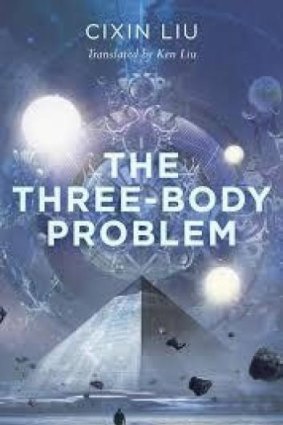By Alison Broinowski
SCIENCE FICTION
THE THREE-BODY PROBLEM
By Cixin Liu. HarperCollins. $27.99.

The Three-Body Problem, by Cixin Liu.
Elon Musk, according to the New York Review of Books, is "The Man for Mars". He's a South African-born American who has made billions since 2000 out of PayPal and Tesla electric cars. His company SolarCity offers "solar services" to Tesla owners, thousands of whom use the home-battery technology Powerwall. As well as all this, his SpaceX aeronautics company which has launched the world's first private rocket into orbit, has 4000 satellites. It aims to put people on Mars by 2026, where Musk proposes to set up an internet system. He makes most of us feel like dinosaurs.
But not Cixin Liu. He vividly recalls the launch of China's first satellite in 1970, when he was seven. It was 13 years after Sputnik, nine years after the first cosmonaut, and a week after Apollo 13 returned from the moon. In Liu's poor village during the Cultural Revolution, popular science books introduced him to the concept of a light year, and a possibly boundless universe. He became a science fiction fan, and is now China's foremost writer of science fiction. The Three Body Problem, published in Chinese in 2012, is one in a trilogy of novels in which he challenges notions of good and evil in hypothetical worlds. Instead of idealising imaginary extraterrestrial societies, which he accuses some sci-fi enthusiasts of doing, he urges our fragile civilisation to be vigilant, and "ready to attribute the worst of intentions to any Others that might exist in space".
If China under the Cultural Revolution was no picnic for Liu's central character Ye Wenjie, who witnessed her scientist father's death at the hands of the Red Guards, and went on to become an astrophysicist, the Trisolar world is infinitely worse. Three suns shine on the planet Trisolaris, with dire effects on gravity and weather. Chinese scientists learn about it in the early 21st century by putting on "haptic feedback suits" and entering the virtual reality world of an online game that seems to drive some to suicide. Using the sun as a superantenna, the secret Red Coast Base works out how to transmit radio waves to the universe and receive replies. Ye delves so far into Trisolaris from Red Coast that, in collaboration with high-energy particle accelerators in North America and Europe, she is able to communicate across millions of light years with its ruthless rulers, hoping to bring their superior civilisation to Earth. But in the process, the Trisolarans' designs for domination of the backward Earth civilisation are revealed.
As long as plenty of the pyrotechnics of advanced technology are included, dedicated sci-fi readers may not mind if Liu's characters are mono-dimensional, living only to explore the universe, and that's how they will understand Ye Wenjie. She comes to life once or twice as a human when she tutors rural children who hope to win science scholarships, and when she meets three disillusioned, ageing former Red Guards, but not when she leads the reactionary faction of scientists, and when she cuts a rope to let her enemy fall off a cliff, together with her husband.
Some readers may find the author's explanatory postscript more enlightening than his fiction. Certainly another postscript, by translator Ken Liu, and his choice of words and footnotes explaining Chinese puns and historical references interest me more than Cixin Liu's imaginary deep space. But a conversation between Cixin Liu and Elon Musk: now that would be out of this world.
Dr Alison Broinowski is a research affiliate at ANU